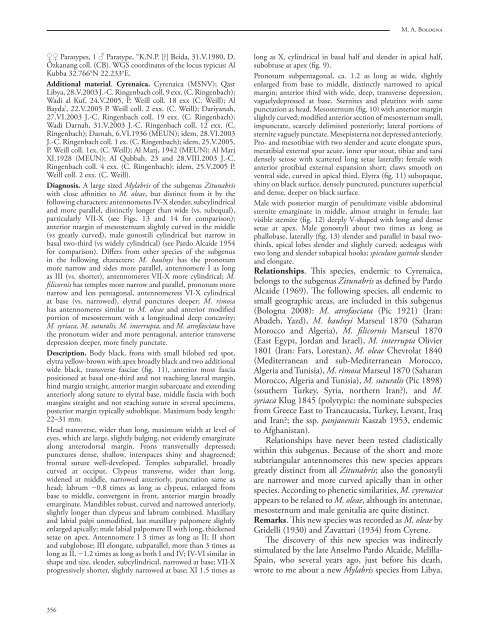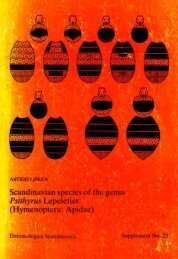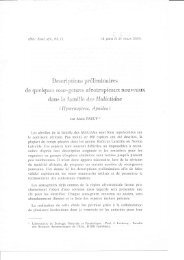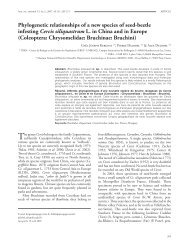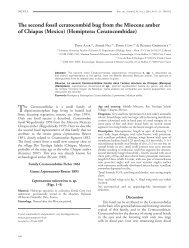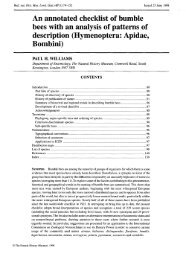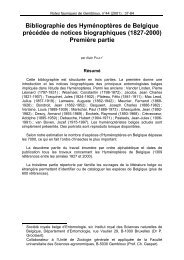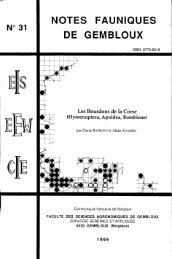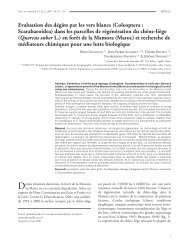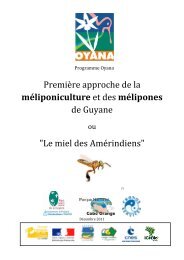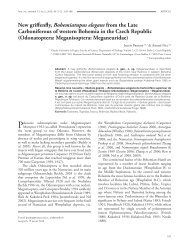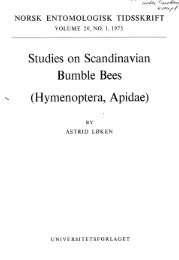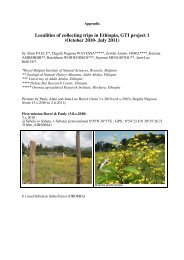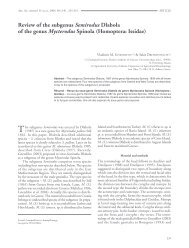Bologna 2009 - Beetles and Rock Art in Libya - Free
Bologna 2009 - Beetles and Rock Art in Libya - Free
Bologna 2009 - Beetles and Rock Art in Libya - Free
Create successful ePaper yourself
Turn your PDF publications into a flip-book with our unique Google optimized e-Paper software.
M. A. <strong>Bologna</strong><br />
♀♀ Paratypes, 1 ♂ Paratype, “K.N.P. [?] Beida, 31.V.1980, D.<br />
Őzkanang coll. (CB). WGS coord<strong>in</strong>ates of the locus typicus: Al<br />
Kubba 32.766°N 22.233°E.<br />
Additional material. Cyrenaica. Cyrenaica (MSNV); Qasr<br />
<strong>Libya</strong>, 28.V.2003 J.-C. R<strong>in</strong>genbach coll. 9 exx. (C. R<strong>in</strong>genbach);<br />
Wadi al Kuf, 24.V.2005, P. Weill coll. 18 exx (C. Weill); Al<br />
Bayda’, 22.V.2005 P. Weill coll. 2 exx. (C. Weill); Dariyanah,<br />
27.VI.2003 J.-C. R<strong>in</strong>genbach coll. 19 exx. (C. R<strong>in</strong>genbach);<br />
Wadi Darnah, 31.V.2003 J.-C. R<strong>in</strong>genbach coll. 12 exx. (C.<br />
R<strong>in</strong>genbach); Darnah, 6.VI.1936 (MEUN); idem, 28.VI.2003<br />
J.-C. R<strong>in</strong>genbach coll. 1 ex. (C. R<strong>in</strong>genbach); idem, 25.V.2005,<br />
P. Weill coll. 1ex. (C. Weill); Al Marj, 1942 (MEUN); Al Marj<br />
XI.1928 (MEUN); Al Qubbah, 23 <strong>and</strong> 28.VIII.2003 J.-C.<br />
R<strong>in</strong>genbach coll. 4 exx. (C. R<strong>in</strong>genbach); idem, 25.V.2005 P.<br />
Weill coll. 2 exx. (C. Weill).<br />
Diagnosis. A large sized Mylabris of the subgenus Zitunabris<br />
with close aff<strong>in</strong>ities to M. oleae, but dist<strong>in</strong>ct from it by the<br />
follow<strong>in</strong>g characters: antennomeres IV-X slender, subcyl<strong>in</strong>drical<br />
<strong>and</strong> more parallel, dist<strong>in</strong>ctly longer than wide (vs. subequal),<br />
particularly VII-X (see Figs. 13 <strong>and</strong> 14 for comparison);<br />
anterior marg<strong>in</strong> of mesosternum slightly curved <strong>in</strong> the middle<br />
(vs greatly curved), male gonostili cyl<strong>in</strong>drical but narrow <strong>in</strong><br />
basal two-third (vs widely cyl<strong>in</strong>drical) (see Pardo Alcaide 1954<br />
for comparison). Differs from other species of the subgenus<br />
<strong>in</strong> the follow<strong>in</strong>g characters: M. baulnyi has the pronotum<br />
more narrow <strong>and</strong> sides more parallel, antennomere I as long<br />
as III (vs. shorter), antennomeres VII-X more cyl<strong>in</strong>drical; M.<br />
filicornis has temples more narrow <strong>and</strong> parallel, pronotum more<br />
narrow <strong>and</strong> less pentagonal, antennomeress VI-X cyl<strong>in</strong>drical<br />
at base (vs. narrowed), elytral punctures deeper; M. rimosa<br />
has antennomeres similar to M. oleae <strong>and</strong> anterior modified<br />
portion of mesosternum with a longitud<strong>in</strong>al deep concavity;<br />
M. syriaca, M. suturalis, M. <strong>in</strong>terrupta, <strong>and</strong> M. atrofasciata have<br />
the pronotum wider <strong>and</strong> more pentagonal, anterior transverse<br />
depression deeper, more f<strong>in</strong>ely punctate.<br />
Description. Body black, frons with small bilobed red spot,<br />
elytra yellow-brown with apex broadly black <strong>and</strong> two additional<br />
wide black, transverse fasciae (fig. 11), anterior most fascia<br />
positioned at basal one-third <strong>and</strong> not reach<strong>in</strong>g lateral marg<strong>in</strong>,<br />
h<strong>in</strong>d marg<strong>in</strong> straight, anterior marg<strong>in</strong> subarcuate <strong>and</strong> extend<strong>in</strong>g<br />
anteriorly along suture to elytral base, middle fascia with both<br />
marg<strong>in</strong>s straight <strong>and</strong> not reach<strong>in</strong>g suture <strong>in</strong> several specimens,<br />
posterior marg<strong>in</strong> typically suboblique. Maximum body length:<br />
22–31 mm.<br />
Head transverse, wider than long, maximum width at level of<br />
eyes, which are large, slightly bulg<strong>in</strong>g, not evidently emarg<strong>in</strong>ate<br />
along anterodorsal marg<strong>in</strong>. Frons transversally depressed;<br />
punctures dense, shallow, <strong>in</strong>terspaces sh<strong>in</strong>y <strong>and</strong> shagreened;<br />
frontal suture well-developed. Temples subparallel, broadly<br />
curved at occiput. Clypeus transverse, wider than long,<br />
widened at middle, narrowed anteriorly, punctation same as<br />
head; labrum ~0.8 times as long as clypeus, enlarged from<br />
base to middle, convergent <strong>in</strong> front, anterior marg<strong>in</strong> broadly<br />
emarg<strong>in</strong>ate. M<strong>and</strong>ibles robust, curved <strong>and</strong> narrowed anteriorly,<br />
slightly longer than clypeus <strong>and</strong> labrum comb<strong>in</strong>ed. Maxillary<br />
<strong>and</strong> labial palpi unmodified, last maxillary palpomere slightly<br />
enlarged apically; male labial palpomere II with long, thickened<br />
setae on apex. Antennomere I 3 times as long as II; II short<br />
<strong>and</strong> subglobose; III elongate, subparallel, more than 3 times as<br />
long as II, ~1.2 times as long as both I <strong>and</strong> IV; IV-VI similar <strong>in</strong><br />
shape <strong>and</strong> size, slender, subcyl<strong>in</strong>drical, narrowed at base; VII-X<br />
progressively shorter, slightly narrowed at base; XI 1.5 times as<br />
long as X, cyl<strong>in</strong>drical <strong>in</strong> basal half <strong>and</strong> slender <strong>in</strong> apical half,<br />
subobtuse at apex (fig. 9).<br />
Pronotum subpentagonal, ca. 1.2 as long as wide, slightly<br />
enlarged from base to middle, dist<strong>in</strong>ctly narrowed to apical<br />
marg<strong>in</strong>; anterior third with wide, deep, transverse depression,<br />
vaguelydepressed at base. Sternites <strong>and</strong> pleurites with same<br />
punctation as head. Mesosternum (fig. 10) with anterior marg<strong>in</strong><br />
slightly curved; modified anterior section of mesosternum small,<br />
impunctate, scarcely delimited posteriorly; lateral portions of<br />
sternite vaguely punctate. Mesepisterna not depressed anteriorly.<br />
Pro- <strong>and</strong> mesotibiae with two slender <strong>and</strong> acute elongate spurs,<br />
metatibial external spur acute, <strong>in</strong>ner spur stout, tibiae <strong>and</strong> tarsi<br />
densely setose with scattered long setae laterally; female with<br />
anterior protibial external expansion short; claws smooth on<br />
ventral side, curved <strong>in</strong> apical third. Elytra (fig. 11) subopaque,<br />
sh<strong>in</strong>y on black surface, densely punctured, punctures superficial<br />
<strong>and</strong> dense, deeper on black surface.<br />
Male with posterior marg<strong>in</strong> of penultimate visible abdom<strong>in</strong>al<br />
sternite emarg<strong>in</strong>ate <strong>in</strong> middle, almost straight <strong>in</strong> female; last<br />
visible sternite (fig. 12) deeply V-shaped with long <strong>and</strong> dense<br />
setae at apex. Male gonostyli about two times as long as<br />
phallobase, laterally (fig. 13) slender <strong>and</strong> parallel <strong>in</strong> basal twothirds,<br />
apical lobes slender <strong>and</strong> slightly curved; aedeagus with<br />
two long <strong>and</strong> slender subapical hooks; spiculum gastrale slender<br />
<strong>and</strong> elongate.<br />
Relationships. This species, endemic to Cyrenaica,<br />
belongs to the subgenus Zitunabris as def<strong>in</strong>ed by Pardo<br />
Alcaide (1969). The follow<strong>in</strong>g species, all endemic to<br />
small geographic areas, are <strong>in</strong>cluded <strong>in</strong> this subgenus<br />
(<strong>Bologna</strong> 2008): M. atrofasciata (Pic 1921) (Iran:<br />
Abadeh, Yazd), M. baulnyi Marseul 1870 (Saharan<br />
Morocco <strong>and</strong> Algeria), M. filicornis Marseul 1870<br />
(East Egypt, Jordan <strong>and</strong> Israel), M. <strong>in</strong>terrupta Olivier<br />
1801 (Iran: Fars, Lorestan), M. oleae Chevrolat 1840<br />
(Mediterranean <strong>and</strong> sub-Mediterranean Morocco,<br />
Algeria <strong>and</strong> Tunisia), M. rimosa Marseul 1870 (Saharan<br />
Morocco, Algeria <strong>and</strong> Tunisia), M. suturalis (Pic 1898)<br />
(southern Turkey, Syria, northern Iran?), <strong>and</strong> M.<br />
syriaca Klug 1845 (polytypic: the nom<strong>in</strong>ate subspecies<br />
from Greece East to Trancaucasia, Turkey, Levant, Iraq<br />
<strong>and</strong> Iran?; the ssp. panjaoensis Kaszab 1953, endemic<br />
to Afghanistan).<br />
Relationships have never been tested cladistically<br />
with<strong>in</strong> this subgenus. Because of the short <strong>and</strong> more<br />
subtriangular antennomeres this new species appears<br />
greatly dist<strong>in</strong>ct from all Zitunabris; also the gonostyli<br />
are narrower <strong>and</strong> more curved apically than <strong>in</strong> other<br />
species. Accord<strong>in</strong>g to phenetic similarities, M. cyrenaica<br />
appears to be related to M. oleae, although its antennae,<br />
mesosternum <strong>and</strong> male genitalia are quite dist<strong>in</strong>ct.<br />
Remarks. This new species was recorded as M. oleae by<br />
Gridelli (1930) <strong>and</strong> Zavattari (1934) from Cyrene.<br />
The discovery of this new species was <strong>in</strong>directly<br />
stimulated by the late Anselmo Pardo Alcaide, Melilla-<br />
Spa<strong>in</strong>, who several years ago, just before his death,<br />
wrote to me about a new Mylabris species from <strong>Libya</strong>.<br />
356


